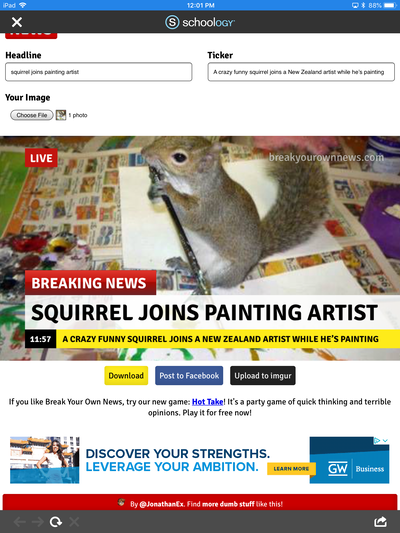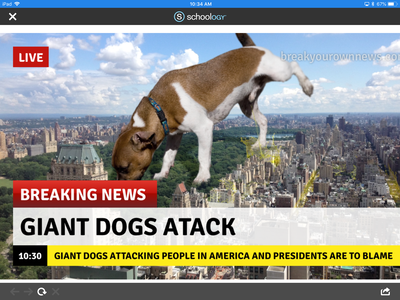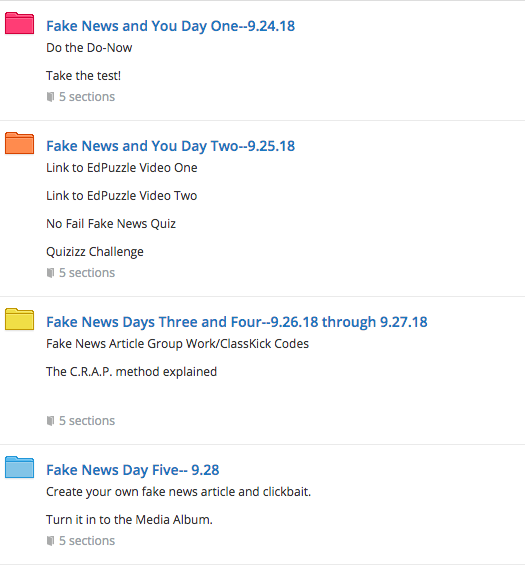|
I have an app called Papier. It's an awesome little bit of code that lets you have a new tab window turn into a notepad. Last year, I had two quotes come out during our fake news unit that I have on that digital notepad to this day. Since the day last year, I have known that I have a duty to teach how to figure out what's true online. I believe fake news education should be mandatory for every ELA teacher on the planet. English teachers have the unique objective to "analyze and evaluate information" (LA 8.1.6f) There isn't a better platform than that really. Here's the lesson plan for how I tackled the issue of fake news. I did place this week long unit after students had generated the first drafts of their descriptive essays; we were on a brain break from writing. I cant decide if I like this lesson more for the hysterically funny results or it's easy for compartmentalizing and digitalizing the results. Organization and Deployment of LessonThe first thing I did was to create all the folders U would need in Schoology to organize all five days of lessons into folders. This is different for me. I will normally group by topic only. However, since I was going to be gone for two days of these lessons, I felt the chronological order helped keep things on track. When the students click on the above folder they see this: Nuts and Bolts of the LessonObjectives:
LA 8.2.1.c Gather and use relevant information and evidence from multiple authoritative print and/or digital sources including primary and secondary sources to support claims or theses. LA 8.1.6.f Analyze and evaluate information from print and digital text features to support comprehension. NOTE: I took about four lessons off the internet and put pasted them together for this lesson--LINK TO THE GOOGLE DOCUMENT PLANS Day One--discussion with the driving question of what is fake news and how sure are we that we have good sources when researching on the internet. Discussion of visual pre-test for fake news from Stanford History Education Group. Use THIS as a link for those classes to practice if there’s extra time or perhaps as homework. Day Two--kids come in practicing spotting Fake news with the Schoology Quick Quiz. . Then, they move on to Independent Work Time where students are watching two videos in edPuzzle to explain what (insesrt edPuzzle Link) Fake News is and how it affects them. Then, they take a “no-fail” (Google Form) Fake News Quiz. Finally, at ten till the end of the period, we close with a Kahoot reviewing all the material we went over that day. Day Three--NearPod of C.R.A.P. Method. Practice telling real news from fake news using this worksheet, a group of kids, and iPads (stipulate they may “use their resources--including the iPad”). This lesson ran long. Extended it to the next day. I do print out the articles in the worksheet. :-) Articles: Trump Bumper Sticker, Dog Shoots Man, and Man Dies When He Shoots Hurricane. Day Four--Give groups time to finish up (mine averaged between 5-15 minutes). Discuss the answers to which are real and which are fake. Allow them to debate and show their proof. Close with a return to the question from the first day about who susceptible are we to Fake News. See if answers have changed or stayed the same. Day Five--I was absent for this day as well. Had a sub. Had students use this time to create Clickbait using “Cooking up Clickbait” from Newseumed.org. Then, after working on paper, have the students use websites like BreakYourOwnNews.com to make their clickbait titles come to life! (show examples).
1 Comment
10/14/2019 12:46:09 am
Fake news have been surrounding our nation, and it is not what I want. As a journalist, it is my passion to actually spread the truth. There is a lot of negative feedback from the people all over the world, but believe me, it is not what we are trying to do. The media are to blame for all of this. If it were not for the fake news that they spread, then we would not have been in this place.
Reply
Leave a Reply. |
Archives
April 2024
Categories |
 RSS Feed
RSS Feed










